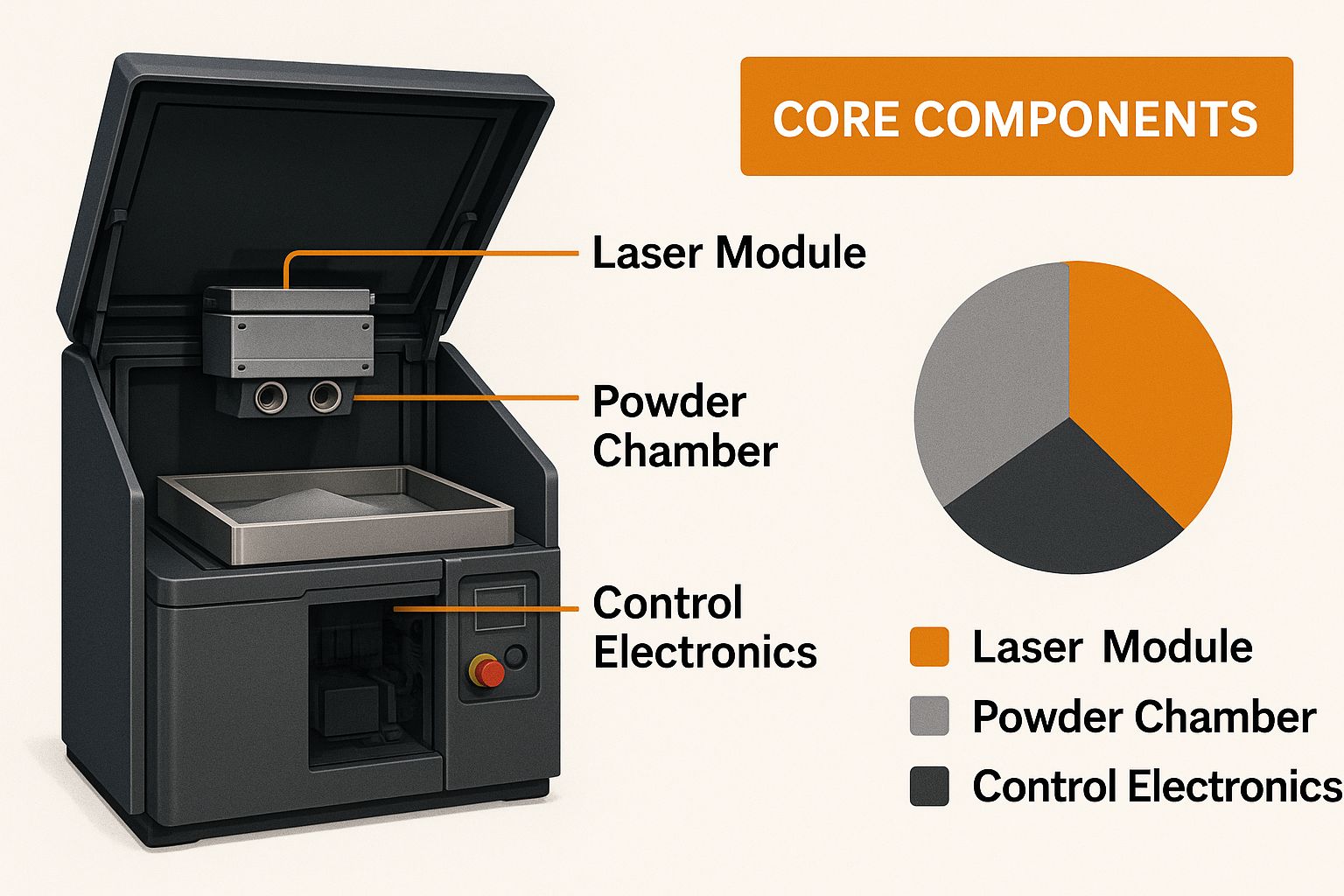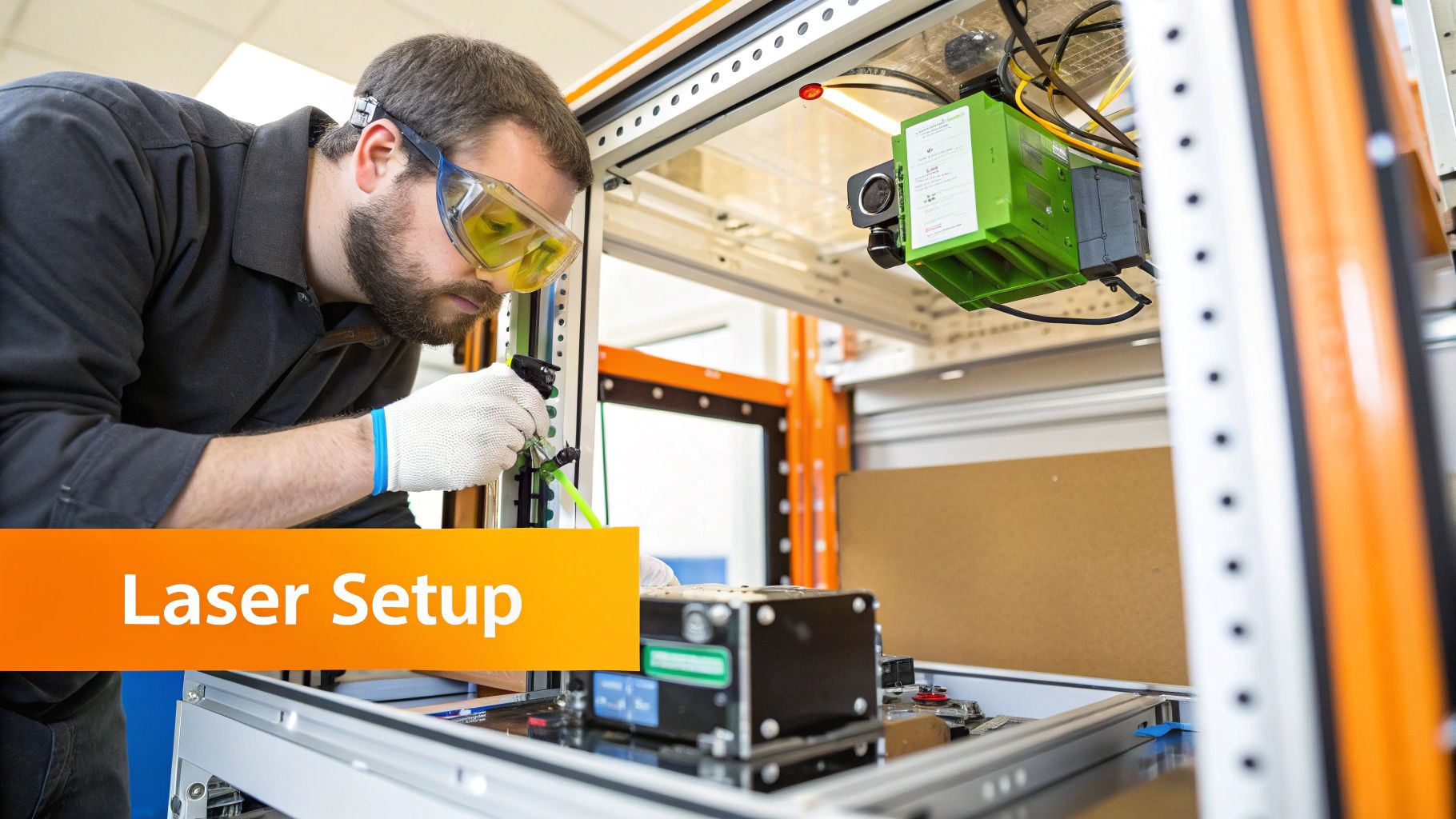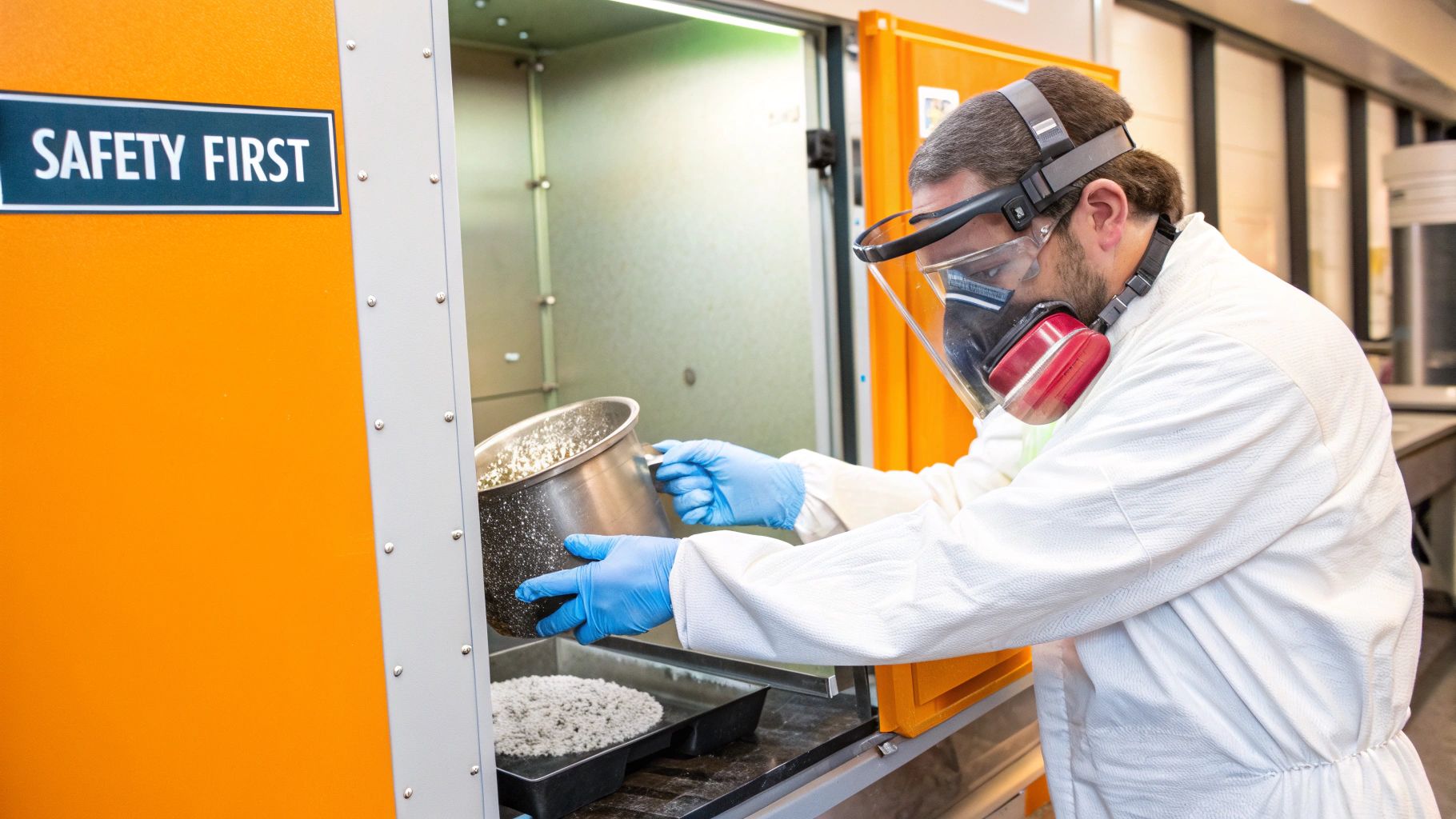SLM 기술 해독: 알아야 할 사항
선택적 레이저 용융(Selective Laser Melting, SLM)은 금속 부품 제작 방식을 변화시키는 강력한 적층 제조 기술입니다. 일반적인 방법인 용융 적층 모델링(FDM)이나 광조형법(SLA)과 달리, SLM은 고출력 레이저를 사용하여 금속 분말을 층층이 녹이고 융합합니다. 이 과정은 매우 복잡한 형상과 뛰어난 기계적 특성을 가진 부품 제작을 가능하게 하며, 종종 전통적인 제조 방식으로 만든 부품보다 우수합니다. 따라서 SLM 3D 프린터 제작에 관심이 있는 사람에게 SLM을 이해하는 것은 매우 중요합니다.
SLM 작동 원리: 심층 분석
SLM의 핵심 원리는 간단하지만 효과적입니다. 얇은 금속 분말 층이 일반적으로 아르곤으로 채워진 밀폐된 챔버 내의 빌드 플랫폼 위에 펼쳐집니다. 강력한 레이저가 부품의 디지털 설계에 따라 정밀한 경로를 따라 분말층을 가로질러 스캔합니다. 레이저의 강렬한 열이 분말 입자를 녹여 단단한 층으로 융합시킵니다. 이 과정이 반복되어 3D 객체가 층층이 쌓입니다. 관련 레이저 주제는 여기에서 탐색할 수 있습니다.
SLM의 장점: 강도와 복잡성
SLM의 주요 장점은 우수한 기계적 특성을 가진 부품을 제작할 수 있다는 점입니다. 빠른 용융과 응고 과정은 조밀하고 균일한 구조를 만듭니다. 이로 인해 마모와 손상에 강한 강력하고 내구성 있는 부품이 만들어집니다. 또한 SLM은 기존 방법으로는 불가능한 정교한 설계와 복잡한 내부 구조를 가능하게 합니다. 이로 인해 SLM은 항공우주, 의료, 자동차 산업의 특수 부품에 적합합니다.
시장 내 SLM: 성장과 잠재력
성장하는 3D 프린팅 시장은 SLM과 같은 첨단 제조 기술에 대한 수요 증가를 강조합니다. 2025년 전 세계 3D 프린팅 시장 가치는 약 292억 9,000만 달러였습니다. 전망에 따르면 이 시장은 2034년까지 1,345억 8,000만 달러에 이를 수 있습니다. 이러한 성장은 건설, 항공우주, 제조업과 같은 분야의 혁신에 의해 촉진됩니다. 관련된 광조형법(SLA) 부문도 2024년에 시장 점유율의 11% 이상을 차지했습니다. 이 성장은 제조업의 미래에 대한 SLM의 상당한 잠재력을 보여줍니다. 더 자세한 통계는 여기에서 확인할 수 있습니다.
이러한 기본 원리를 이해하는 것이 SLM 3D 프린터를 성공적으로 구축하는 첫 번째 단계입니다. 이후 섹션에서는 이 복잡하지만 보람 있는 프로젝트에 필요한 구체적인 부품과 조립 과정을 살펴볼 것입니다.
기본 요소: 중요한 필수 구성 요소
선택적 레이저 용융(SLM) 3D 프린터를 만드는 것은 단순히 복잡한 금속 물체를 만들고자 하는 것만이 아닙니다. 이는 핵심 부품과 그 상호작용에 대한 확실한 이해를 요구합니다. 이 부품들은 금속 분말을 정교한 디자인으로 변환할 수 있는 정밀하고 강력한 기계를 만들기 위해 함께 작동합니다. 성공적인 출력물을 위해서는 적절한 하드웨어 선택이 매우 중요합니다. SLM 3D 프린터를 작동하게 하는 중요한 요소들을 살펴보겠습니다.
시스템의 핵심: 레이저
레이저는 모든 SLM 3D 프린터의 핵심에 위치합니다. 이는 금속 분말을 녹이는 강력한 에너지원입니다. 와트 수가 중요한 요소이지만, 빔 품질과 안정성도 똑같이 중요합니다. 고품질 파이버 레이저는 효과적인 SLM 인쇄에 필요한 정밀한 제어와 일관된 에너지를 제공합니다. 적절한 레이저를 선택하려면 출력, 정밀도, 예산의 균형을 맞춰야 합니다.
분말 취급: 정밀함과 제어
정확한 분말 취급은 일관된 출력물과 안전한 작업 환경을 위해 필수적입니다. 이는 금속 분말의 정밀한 공급, 분포 및 재활용을 포함합니다. 결함이 있는 시스템은 분말 오염, 불균일한 층 두께 및 안전 위험을 초래할 수 있습니다. 신뢰할 수 있고 정확한 분말 취급 메커니즘은 고품질 출력을 보장합니다.
대기 제어: 불활성 환경
SLM 프린팅은 빌드 챔버 내부의 제어된 환경을 요구합니다. 이는 일반적으로 아르곤이나 질소와 같은 불활성 가스를 사용하는 것을 포함합니다. 이 가스들은 용융 과정 중 산화 및 기타 원치 않는 반응을 방지합니다. 이러한 제어된 환경을 유지하는 것이 강하고 내구성 있는 부품을 생산하는 데 핵심입니다.
온도 관리: 비용이 많이 드는 고장 방지
정확한 온도 제어는 SLM 인쇄에 매우 중요합니다. 빠른 가열과 냉각은 신중하게 관리하지 않으면 휨, 균열 또는 기타 결함을 초래할 수 있습니다. 빌드 챔버 내에서 안정적인 온도 유지가 필수적입니다. 효과적인 온도 제어 조치는 이러한 문제를 방지하여 우수한 인쇄 품질을 보장합니다.
프로세스 조율: 스캐닝 및 모션 제어
갈바노미터 스캐닝 시스템은 레이저 빔을 분말 베드 위로 안내하여 원하는 디자인을 따라갑니다. 이 시스템은 빌드 플랫폼을 정밀하게 이동시키는 모션 제어 시스템과 함께 작동합니다. 이들 시스템의 동기화된 움직임은 정확하고 세밀한 출력의 핵심입니다. 정밀한 제어와 이 요소들 간의 조정은 복잡한 기하학적 형상을 구현하는 데 매우 중요합니다.
숨은 영웅들: 전자제품과 소프트웨어
전자 장치와 소프트웨어는 프린터의 두뇌 역할을 하며, 프로세스의 모든 측면을 제어합니다. 이들은 레이저 출력, 스캔 패턴, 플랫폼 이동 및 대기 조건을 관리합니다. 신뢰할 수 있고 잘 통합된 전자 장치는 안정적이고 성공적인 인쇄 과정을 보장합니다. 하드웨어와 소프트웨어 간의 원활한 통신이 필수적입니다.
부품 비교 및 비용 고려사항
아래 표는 필수 구성 요소, 그 기능, 예상 비용 범위 및 상대적인 제작 복잡도(1이 가장 간단하고 5가 가장 복잡함)를 요약한 것입니다. 다음 데이터 차트는 이 정보를 시각적으로 나타내어 비용과 복잡도를 명확하게 비교할 수 있도록 합니다.
| 요소 | 기능 | 예상 비용 범위 ($) | 빌드 복잡도 (1-5) |
|---|---|---|---|
| 파이버 레이저 | 금속 분말을 녹이고 융합합니다 | 5,000~20,000+ | 5 |
| 분말 취급 시스템 | 금속 분말을 전달, 분산 및 재활용합니다 | 1,000 - 5,000 | 4 |
| 불활성 가스 시스템 | 빌드 챔버 내에서 무산소 환경을 유지합니다 | 500 - 2,000 | 3 |
| 온도 제어 시스템 | 빌드 챔버 내의 온도를 조절합니다 | 500 - 2,000 | 3 |
| 갈바노미터 스캐닝 시스템 | 레이저 빔을 분말층 위로 이동시킵니다 | 1,000 - 3,000 | 4 |
| 모션 제어 시스템 | 정확하게 빌드 플랫폼을 이동합니다 | 500 - 2,000 | 3 |
| 전자 및 소프트웨어 | 전체 인쇄 과정을 제어하고 관리합니다 | 500 - 1,500 | 4 |

이 데이터 차트는 SLM 3D 프린터를 구축하는 데 필요한 각 구성 요소의 비용과 복잡성을 시각화합니다. 차트가 명확히 보여주듯이, 파이버 레이저가 가장 큰 투자이며, 그 다음으로 분말 처리 및 스캐닝 시스템이 뒤따릅니다. 차트는 또한 레이저 및 분말 처리 시스템의 복잡성을 강조하여 이러한 구축 단계에서 신중한 계획의 중요성을 부각시킵니다. 이 정보는 제작자가 성능 요구 사항과 예산 제약을 균형 있게 고려하여 정보에 입각한 선택을 할 수 있도록 돕습니다. 이러한 핵심 구성 요소를 철저히 이해하는 것은 성공적인 SLM 3D 프린터 구축의 기초를 마련합니다.
SLM 프린터 조립 가이드: 시작하기

이 안내서는 SLM 3D 프린터 조립 과정을 안내합니다. 개별 부품부터 완전한 작동 기계에 이르기까지, 초기 프레임 구성부터 최종 시스템 보정까지 모든 단계를 다룹니다. 안전하고 효과적으로 작동하는 SLM 3D 프린터를 만들기 위해서는 신중한 조립이 가장 중요하다는 점을 기억하세요.
튼튼한 기초 다지기: 프레임 구조
진동을 최소화하는 데 필수적인 강체 프레임은 정밀한 인쇄를 달성하는 데 중요한 요소입니다. 많은 제작자들이 모듈성 및 간단한 조립 때문에 알루미늄 압출재를 선택합니다.
그러나 더 큰 빌드를 계획하고 있다면, 강철 프레임워크가 더 우수한 안정성을 제공합니다. 프레임 재료를 선택할 때는 프린터의 용도와 전체 크기를 신중하게 고려하세요.
이 결정은 귀하의 SLM 프린터의 장기적인 정확성과 안정성에 상당한 영향을 미칠 것입니다.
제어 환경 만들기: 빌드 챔버 조립
빌드 챔버는 인쇄 과정 중 산화를 방지하기 위해 불활성 분위기를 유지하는 데 중요한 역할을 합니다. 이를 위해서는 잘 밀폐된 인클로저가 필요합니다.
모든 이음새와 연결 부위를 주의 깊게 살펴 누수가 발생하지 않도록 제대로 밀봉되었는지 확인하세요. 적절한 실란트를 사용하고 챔버 문이 확실히 닫히도록 하십시오. 챔버가 단단히 밀봉되는 것은 성공적인 SLM 인쇄의 기본입니다.
이 제어된 환경은 레이저 용융 공정의 일관성을 보장합니다.
정밀도를 위한 위치 지정: 레이저 장착
정확한 레이저 배치는 일관된 인쇄 결과를 얻기 위해 절대적으로 중요합니다. 제조업체의 지침에 따라 레이저를 신중하게 장착하십시오.
정확한 정렬은 레이저가 분말층에 올바르게 초점을 맞추도록 보장합니다. 작은 편차라도 고르지 않은 용융과 부품 품질 저하를 초래할 수 있습니다.
다음 단계로 넘어가기 전에 정렬 상태를 다시 한 번 확인하세요. 이러한 꼼꼼한 접근 방식이 궁극적으로 고품질 인쇄물을 만들어냅니다.
파우더 베드 메커니즘: 부드럽고 일관된 층
리코터는 신선한 분말 층을 분배하는 역할을 하며 최종 인쇄 품질에 큰 영향을 미칩니다. 부드럽고 일관된 분말 분포가 핵심입니다.
블레이드의 각도와 분말층에 가하는 압력과 같은 리코터 설계의 작은 조정만으로도 성능이 크게 향상될 수 있습니다. 이러한 겉보기에는 작은 세부 사항들이 각 인쇄된 층의 품질에 큰 영향을 미칩니다.
배선 및 제어 시스템: 두뇌 연결
제어 시스템 배선은 세심한 주의가 필요합니다. 자세한 배선도를 따라 모든 부품을 꼼꼼하게 연결하세요.
비상 정지를 포함한 필수 안전 회로를 반드시 구현하여 자신과 장비를 보호하세요. 전기 안전을 보장하고 잠재적인 작동 문제를 최소화하기 위해 모든 연결의 접지 상태를 다시 한 번 확인하세요.
보정: 최적 성능을 위한 미세 조정
하드웨어 조립이 완료된 후, 보정은 마지막이자 중요한 단계입니다. 이 과정은 레이저, 갈바노미터, 그리고 모션 제어 시스템을 미세 조정하는 것을 포함합니다.
적절한 보정은 모든 구성 요소가 조화롭게 작동하도록 하여 정확하고 일관된 인쇄 결과를 보장합니다. 이는 조립된 부품들을 조정된 인쇄 시스템으로 변환합니다.
철저한 보정은 최적의 성능을 달성하는 데 필수적입니다. 적절한 보정을 통해 귀하의 SLM 3D 프린터는 디자인을 현실로 구현할 준비가 될 것입니다.
안전 우선: 자신과 작업장을 보호하기

선택적 레이저 용융(SLM) 3D 프린터를 제작하고 사용하는 데는 고유한 안전 고려 사항이 포함됩니다. 이 섹션에서는 SLM 프린터의 제작 및 작동 중에 자신과 작업 공간을 보호하기 위한 주요 예방 조치를 설명합니다. 이러한 안전 조치는 이 프로젝트를 수행하는 모든 사람에게 매우 중요합니다.
레이저 안전: 눈과 피부 보호
고출력 레이저는 SLM 프린팅에 필수적이지만, 눈과 피부에 심각한 위험을 초래할 수 있습니다. 특정 레이저 파장에 맞게 설계된 적절한 눈 보호구는 절대적으로 필요합니다. 비반사 재료로 제작된 인쇄 구역 주변의 인클로저도 매우 중요합니다. 이러한 인클로저는 레이저 반사를 차단하여 우발적인 노출 위험을 최소화하는 데 도움을 줍니다. 레이저 안전을 최우선으로 고려해야 합니다.
금속 분말 취급: 호흡기 보호
SLM 프린팅에 사용되는 미세 금속 분말을 다룰 때, 일반 작업장용 방진 마스크는 충분하지 않습니다. 이 분말은 쉽게 흡입될 수 있어 잠재적인 건강 위험을 초래할 수 있습니다. HEPA 필터가 장착된 호흡기는 금속 분말을 다루거나 근처에 있을 때 필수입니다. 많은 경험 많은 제작자들은 SLM 프린팅에 널리 퍼진 미세 입자에 대해 최고 수준의 보호를 제공하는 P100 필터가 장착된 호흡기를 선택합니다.
폭발 위험: 안전한 보관 및 취급
특정 조건에서는 미세 금속 분말이 놀라울 정도로 폭발할 수 있습니다. 위험한 상황을 방지하려면 적절한 보관과 취급이 매우 중요합니다. 금속 분말은 밀폐 용기에 보관하고, 점화원에서 멀리 떨어진 서늘하고 건조한 장소에 보관하십시오. 이러한 방법은 분진 폭발 위험을 크게 줄여줍니다. 안전 취급 방법에 대한 자세한 내용은 레이저 안전 프로토콜 가이드에서 확인할 수 있습니다. 또한 분말을 다룰 때 분진 구름이 생기지 않도록 주의해야 하며, 이는 폭발 위험을 크게 높일 수 있습니다.
전기 안전: 접지 및 고전력 시스템
SLM 프린터는 고출력 전기 시스템을 사용하므로 감전 방지를 위해 적절한 접지가 매우 중요합니다. 전기 배선에 대한 모범 사례를 준수하고 프린터 프레임, 레이저 전원 공급 장치, 제어 전자 장치를 포함한 모든 구성 요소가 올바르게 접지되어 있는지 확인하십시오. 프린터의 특정 전압 및 전류 요구 사항에 맞는 고품질 배선과 부품을 사용하면 전기 위험을 더욱 줄일 수 있습니다.
불활성 가스 관리: 산소 고갈
SLM 프린팅에 사용되는 비활성 가스는 빌드 챔버 내에 산소가 없는 환경을 만듭니다. 그러나 이러한 가스는 주변 작업장의 산소를 대체할 수 있어 산소 결핍을 초래할 수 있습니다. 안전한 호흡 환경을 유지하기 위해 적절한 환기가 필수적입니다. 산소 모니터를 사용하여 산소 수준의 감소를 감지하고 충분한 환기를 보장하여 이 조용하지만 심각한 위험을 예방하십시오.
화재 진압: 금속 분말 화재 대응
금속 분말 화재는 전문적인 화재 진압 방법이 필요합니다. 전통적인 수성 시스템은 오히려 이러한 화재를 악화시킬 수 있습니다. 보다 안전한 접근을 위해 클래스 D 소화기 또는 금속 화재 전용으로 설계된 다른 전문 진압 시스템을 고려하십시오. 작업장 환경에서는 명확한 화재 안전 계획을 갖추는 것이 매우 중요합니다. 참고로, Stereolithography (SLA)는 SLM과 관련된 기술로 빠르게 성장하고 있습니다. 2024년 24억 8천만 달러(USD 2.48 Billion)로 평가된 SLA 시장은 2033년까지 188억 6천만 달러(USD 18.86 Billion)에 이를 것으로 예상됩니다.
이러한 안전 수칙을 성실히 준수함으로써 SLM 3D 프린터를 제작하고 사용하는 데 따른 위험을 상당히 줄일 수 있습니다. 안전한 작업 환경은 이 강력한 기술의 창의적이고 혁신적인 잠재력에 집중할 수 있게 해줍니다. 안전이 항상 최우선임을 기억하세요.
기본에서 탁월함으로: SLM 프린터 최적화
선택적 레이저 용융(SLM) 3D 프린터를 제작하는 것은 큰 성과입니다. 하지만 진정한 시험은 전문적인 품질의 출력물을 얻기 위해 성능을 미세 조정하는 데 있습니다. 이 섹션에서는 기본 SLM 프린터를 고성능 기계로 향상시키는 기술을 탐구합니다. 프린터의 잠재력을 최대한 발휘할 수 있는 필수 조정 및 보정 방법을 다룰 것입니다.
레이저 보정: 출력과 정밀도
레이저 보정은 매우 중요합니다. 이는 레이저가 일관된 출력을 제공하고 전체 제작 플랫폼에서 선명한 초점을 유지하도록 미세 조정하는 것을 포함합니다. 출력이 불안정하면 금속 분말이 약하게 녹거나 완전히 녹지 않을 수 있습니다. 초점이 맞지 않은 레이저 빔은 해상도가 낮고 치수가 부정확하게 됩니다. 정밀한 보정은 일관된 에너지 전달을 보장하여 고품질의 출력 부품을 만듭니다.
분말 베드 매개변수: 층 두께 및 재도포 속도
분말 베드 매개변수는 최종 제품에 큰 영향을 미칩니다. 층 두께는 해상도와 표면 마감에 영향을 줍니다. 두꺼운 층은 인쇄 속도가 빠르지만 세부 사항이 희생되어 거친 표면을 만듭니다. 얇은 층은 인쇄 시간이 길어지지만 더 부드럽고 세밀한 표면을 만듭니다. 재도포 속도—블레이드가 신선한 분말을 퍼뜨리는 속도—도 중요한 역할을 합니다. 너무 빠르면 고르지 않은 분포가 발생할 수 있고, 너무 느리면 제작 시간이 늘어납니다. 이러한 매개변수 간의 적절한 균형을 찾는 것이 핵심입니다.
빌드 플랫폼 수정: 뒤틀림 방지
SLM 프린팅에서 흔히 발생하는 부품 뒤틀림은 제작 중 열 스트레스로 인해 부품이 변형될 때 발생합니다. 빌드 플랫폼을 수정하면 이를 방지하는 데 도움이 됩니다. 가열된 빌드 플랫폼은 보다 균일한 온도를 유지하여 뒤틀림을 최소화합니다. 더 고급 기술로는 예열 사이클을 사용하거나 열전도성이 우수한 재료로 만든 플랫폼을 사용하는 방법이 있습니다. 온도 제어와 플랫폼 준비를 마스터하는 방법에 대한 더 많은 통찰력을 제공합니다.
대기 제어 개선: 가스 흐름 및 모니터링
빌드 챔버 내의 대기는 성공적인 SLM 인쇄에 매우 중요합니다. 가스 흐름 패턴을 최적화하면 분말 베드가 지속적으로 불활성 가스로 덮이게 됩니다. 이는 산화를 방지하고 최종 부품의 밀도를 향상시킵니다. 가스 조성을 모니터링하면 빌드 환경에 대한 귀중한 데이터를 제공합니다. 이를 통해 사전 조정이 가능하여 최적의 인쇄 조건을 유지하고 잠재적인 문제를 방지할 수 있습니다.
소프트웨어 최적화: 정밀 성능
소프트웨어는 SLM 프린팅의 제어 센터입니다. 레이저 스캐닝 속도와 해치 간격과 같은 매개변수를 최적화하면 전체 프로세스를 미세 조정할 수 있습니다. 기공(부품 내의 작은 빈 공간) 및 표면 마감 문제와 같은 일반적인 문제는 종종 소프트웨어 조정을 필요로 합니다. 구조적 무결성에 대한 우려도 소프트웨어 조정을 통해 해결할 수 있어 최종 부품이 원하는 강도와 내구성을 갖추도록 보장합니다.
일반적인 문제 해결
다음 표는 일반적인 SLM 인쇄 문제에 대한 해결책을 제공합니다. 잠재적인 원인을 식별하고 실용적인 문제 해결 단계를 제안합니다.
일반적인 SLM 인쇄 문제 및 해결책
| 문제 | 가능한 원인 | 솔루션 |
|---|---|---|
| 다공성 | 갇힌 가스, 불충분한 레이저 출력 | 레이저 출력 조정, 분말 예열, 스캔 매개변수 최적화 |
| 표면 마감 | 잘못된 층 두께, 리코터 블레이드 문제 | 레이어 두께 조정, 리코터 속도 최적화, 다양한 분말 고려 |
| 워핑 | 열 응력, 불균일 냉각 | 가열된 빌드 플랫폼을 사용하고, 빌드 방향을 최적화하며, 예열을 구현하세요 |
이러한 핵심 영역을 해결함으로써 SLM 3D 프린터의 성능을 극적으로 향상시킬 수 있습니다. 이러한 세심한 최적화는 프린터가 최대 잠재력에 도달하여 고품질의 정교한 금속 부품을 생산할 수 있게 합니다.
분말 및 용품: 그것을 가능하게 하는 재료
성공적인 선택적 레이저 용융(Selective Laser Melting, SLM) 3D 프린터를 구축하는 것은 단순히 올바른 하드웨어를 조립하는 것 이상을 포함합니다. 특히 금속 분말과 같은 재료 선택은 완성된 출력물의 품질과 가능성에 직접적인 영향을 미칩니다. 이 섹션에서는 이러한 특수 재료를 안전하고 효과적으로 선택, 보관 및 사용할 때 고려해야 할 필수 요소들을 탐구합니다.
적합한 금속 분말 선택: 특성 및 고려 사항
SLM 3D 프린팅에서 적절한 금속 분말을 선택하는 것은 매우 중요합니다. 서로 다른 분말은 인쇄 과정과 최종 부품의 특성에 영향을 미치는 고유한 특성을 가지고 있습니다. 입자 크기 분포는 분말의 흐름과 분말이 얼마나 조밀하게 뭉치는지를 결정하는 핵심 요소입니다. 일관된 입자 크기는 더 부드럽고 균일한 분말층을 만들어내며, 이는 고품질 인쇄에 필수적입니다. 형태학은 분말 입자의 모양을 의미하며, 최종 부품의 밀도와 기계적 특성에도 영향을 미칩니다. 구형 입자가 일반적으로 선호되는데, 이는 흐름성과 포장성이 일관되기 때문입니다.
DIY 세트를 위한 금속 분말 옵션: 성능과 실용성의 균형
여러 금속 분말이 DIY SLM 설정에 적합합니다. 스테인리스 스틸, 특히 316L은 상대적으로 저렴한 비용, 인쇄 용이성, 부식 저항성 때문에 인기 있는 선택입니다. 알루미늄 합금, 예를 들어 AlSi10Mg는 가벼우면서도 강도를 제공하지만 반응성이 있어 더 엄격한 환경이 필요합니다. 티타늄과 인코넬과 같은 다른 재료는 뛰어난 성능을 제공하지만 더 비싸고 복잡한 취급이 필요합니다.
안전한 보관 및 취급: 위험 및 오염 방지
금속 분말은 잠재적인 위험 때문에 신중한 취급과 보관이 필요합니다. 미세 금속 분말은 특정 조건에서 가연성 또는 폭발성일 수 있습니다. 분말은 밀폐 용기에 보관하고, 서늘하고 건조한 장소에 두며, 점화할 수 있는 물질과는 떨어뜨려 보관하는 것이 중요합니다. 금속 분말을 다룰 때는 항상 HEPA 필터가 장착된 호흡기와 장갑을 포함한 적절한 개인 보호 장비(PPE)를 착용해야 합니다. 이러한 안전 조치는 흡입 및 오염 위험을 줄여 안전한 작업 환경을 만듭니다.
불활성 가스 선택: 아르곤 대 질소
아르곤과 질소 중에서 불활성 가스를 선택하는 것은 인쇄 공정에 영향을 미칩니다. 아르곤은 특히 알루미늄이나 티타늄과 같은 반응성 금속을 인쇄할 때 우수한 불활성 때문에 일반적으로 선호됩니다. 그러나 질소는 일부 응용 분야에서 더 경제적인 선택이 될 수 있습니다. 최상의 선택은 특정 금속과 완성된 부품의 원하는 특성에 따라 다릅니다. 비용과 성능을 저울질하는 것이 정보에 입각한 선택을 하는 데 도움이 됩니다.
소모품 및 유지보수: 수명 연장
SLM 3D 프린터의 일부 부품은 마모되기 쉬워 주기적으로 교체해야 합니다. 레이저 윈도우는 레이저 광학 장치를 분말과 튀는 물질로부터 보호하며, 정기적인 청소와 결국 교체가 필요합니다. 분말을 펼치는 리코터 블레이드도 시간이 지남에 따라 마모될 수 있습니다. 청소와 적절한 정렬을 포함한 정기적인 유지보수는 이러한 소모품의 수명을 연장하여 프린터의 성능을 최적화하고 운영 비용을 줄입니다.
후처리: 인쇄물 다듬기
출력 후에는 원시 출력물을 완성된 부품으로 만들기 위해 후처리 단계가 필요합니다. 서포트 제거가 보통 첫 번째 단계이며, 종종 부품의 기계적 특성을 향상시키기 위해 열처리가 뒤따릅니다. 가공 및 표면 마감 기술은 부품을 정밀한 요구 사항에 맞게 더욱 정제합니다. 구체적인 후처리 단계는 사용된 재료와 출력된 부품의 용도에 따라 다릅니다.
적절한 금속 분말 선택부터 적절한 후처리 보장에 이르기까지, 재료와 공급품의 세부 사항을 이해하는 것은 성공적인 SLM 3D 프린팅에 매우 중요합니다. 이 지식은 귀하가 요구에 맞춘 고품질 부품을 제작하고 이 첨단 기술을 최대한 활용할 수 있도록 합니다. 레이저 및 제조에 대한 더 심층적인 정보를 원하십니까? Laser Insights China를 방문하세요 https://laser-podcast.com 전문가 통찰력, 기술 자료 및 혁신가 커뮤니티를 위해.

